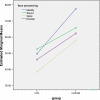Is theory of mind related to social dysfunction and emotional problems in 22q11.2 deletion syndrome (velo-cardio-facial syndrome)?
- PMID: 21544568
- PMCID: PMC3188292
- DOI: 10.1007/s11689-011-9082-7
Is theory of mind related to social dysfunction and emotional problems in 22q11.2 deletion syndrome (velo-cardio-facial syndrome)?
Abstract
Social dysfunction is intrinsically involved in severe psychiatric disorders such as depression and psychosis and linked with poor theory of mind. Children with 22q11.2 deletion syndrome (22q11DS, or velo-cardio-facial syndrome) have poor social competence and are also at a particularly high risk of developing mood (40%) and psychotic (up to 30%) disorders in adolescence and young adulthood. However, it is unknown if these problems are associated with theory of mind skills, including underlying social-cognitive and social-perceptual mechanisms. The present cross-sectional study included classic social-cognitive false-belief and mentalising tasks and social-perceptual face processing tasks. The performance of 50 children with 22q11DS was compared with 31 age-matched typically developing sibling controls. Key findings indicated that, while younger children with 22q11DS showed impaired acquisition of social-cognitive skills, older children with 22q11DS were not significantly impaired compared with sibling controls. However, children with 22q11DS were found to have social-perceptual deficits, as demonstrated by difficulties in matching faces on the basis of identity, emotion, facial speech and gaze compared with sibling controls. Furthermore, performance on the tasks was associated with age, language ability and parentally rated social competence and emotional problems. These results are discussed in relation to the importance of a better delineation of social competence in this population.
Figures
Similar articles
-
Social cognition dysfunction in adolescents with 22q11.2 deletion syndrome (velo-cardio-facial syndrome): relationship with executive functioning and social competence/functioning.J Intellect Disabil Res. 2015 Sep;59(9):845-59. doi: 10.1111/jir.12183. Epub 2015 Feb 25. J Intellect Disabil Res. 2015. PMID: 25726953
-
An fMRI study of facial emotion processing in children and adolescents with 22q11.2 deletion syndrome.J Neurodev Disord. 2015;7(1):1. doi: 10.1186/1866-1955-7-1. Epub 2015 Jan 2. J Neurodev Disord. 2015. PMID: 25972975 Free PMC article.
-
Visual perception and processing in children with 22q11.2 deletion syndrome: associations with social cognition measures of face identity and emotion recognition.J Neurodev Disord. 2016 Aug 17;8:30. doi: 10.1186/s11689-016-9164-7. eCollection 2016. J Neurodev Disord. 2016. PMID: 27536336 Free PMC article.
-
[Neurocognitive and psychiatric management of the 22q11.2 deletion syndrome].Encephale. 2015 Jun;41(3):266-73. doi: 10.1016/j.encep.2014.10.005. Epub 2014 Dec 16. Encephale. 2015. PMID: 25523123 Review. French.
-
Social cognitive impairment in 22q11 deletion syndrome: A review.Psychiatry Res. 2017 Jul;253:99-106. doi: 10.1016/j.psychres.2017.01.103. Epub 2017 Feb 23. Psychiatry Res. 2017. PMID: 28364592 Review.
Cited by
-
Brain morphometry in 22q11.2 deletion syndrome: an exploration of differences in cortical thickness, surface area, and their contribution to cortical volume.Sci Rep. 2020 Nov 2;10(1):18845. doi: 10.1038/s41598-020-75811-1. Sci Rep. 2020. PMID: 33139857 Free PMC article.
-
Understanding others: a pilot investigation of cognitive and affective facets of social cognition in patients with 22q11.2 deletion syndrome (22q11DS).J Neurodev Disord. 2017 Sep 25;9(1):35. doi: 10.1186/s11689-017-9216-7. J Neurodev Disord. 2017. PMID: 28946869 Free PMC article.
-
Comparing the neural bases of self-referential processing in typically developing and 22q11.2 adolescents.Dev Cogn Neurosci. 2012 Apr;2(2):277-89. doi: 10.1016/j.dcn.2011.12.004. Epub 2012 Jan 3. Dev Cogn Neurosci. 2012. PMID: 22483077 Free PMC article.
-
An implicit and reliable neural measure quantifying impaired visual coding of facial expression: evidence from the 22q11.2 deletion syndrome.Transl Psychiatry. 2019 Feb 4;9(1):67. doi: 10.1038/s41398-019-0411-z. Transl Psychiatry. 2019. PMID: 30718458 Free PMC article.
-
Deficits in mental state attributions in individuals with 22q11.2 deletion syndrome (velo-cardio-facial syndrome).Autism Res. 2012 Dec;5(6):407-18. doi: 10.1002/aur.1252. Epub 2012 Sep 7. Autism Res. 2012. PMID: 22962003 Free PMC article.
References
-
- Bishop DVM. The test for reception of grammar (TROG). 2nd edition. Published by the author and available from Age and Cognitive Performance Research Centre, University of Manchester, M13 9PL, UK; 1983.
LinkOut - more resources
Full Text Sources

